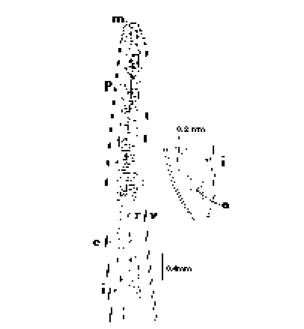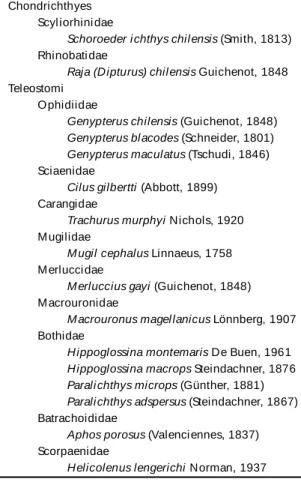31
Universidade de São Paulo Faculdade de Saúde Pública
VO LU M E 31
N Ú M ERO 2
ABRIL 1997
Revista de Saúde Pública
J O
U
R
N
A
L
O
F
P
U
B
L
I
C
H
E
A
L
T
H
© Copyright Faculdade de Saúde Pública da USP. Proibida a reprodução mesmo que parcial sem a devida autorização do Editor Científico. Proibida a utilização de matérias para fins comerciais. All rights reserved.
H uman case of gastric infection by a fourth
larval stage of Pseudoterranova decipiens
(N ematoda, Anisakidae)
Relato de parasitismo por nematódeo Anisakidae em homem
Rubén M ercado, Patricio Torres and Jorge M aira
Departamento de Parasitología de la Universidad de Chile. Santiago, Chile (R.M.); Instituto
de Parasitología de la Universidad Austral de Chile. Valdivia, Chile (P.T.); Clínica
Integramédica. Sección Gastroenterología. Santiago, Chile (J.M.)
MERCADO, Rubén, Human case of gastric infection by a fourth larval stage of Pseudoterranova decipiens (Nematoda, Anisakidae). Rev. Saúde Pública, 31 (2): 178-81, 1997.
Abstract
Only three cases of human infection by anisakid nematodes have been reported in Chile since 1976. In the present case, an anisakid worm, identified as a fourth-stage Pseudoterranova decipiens larva, was removed with a gastroen-doscopic biopsy clipper from the stomach of a 45 year-old man from southern Chile. The patient, who presented acute epigastric pain and a continuous sensation of having an empty stomach, reported having eaten smoked fish. The worm was fixed in 70% ethanol and cleaned in lactophenol for morphological study. The morphometric characteristics of the worm are described and drawn. Anisakid larvae in fish flesh can be killed by freezing or cooking.
Nematode infections. Anisakiasis.
Resumo
Um anisakidio, identificado como larva do quarto estágio de Pseudoterranova
decipiens, foi isolado por gastroendoscopia do estômago de uma pessoa de 45
anos de idade, residente no Sul do Chile. Relata-se que o paciente apresentou dor epigástrica aguda e sensação de estômago vazio, tendo ingerido peixe de-fumado. O nematode foi fixado em etanol 70% e diafanizado com lactofenol para estudo morfológico.
Infecções por nematóides. Anisaquiase.
H uman case of gastric infection by a fourth larval
stage of
Pseudoterranova decipiens
(N ematoda, Anisakidae)*
Relato de parasitismo por nematódeo Anisakidae em homem
Rubén M ercado, Patricio Torres and Jorge M aira
Departamento de Parasitología de la Universidad de Chile. Santiago, Chile (R.M .); Instituto de Parasitología de la U niversidad Austral de Chile. Valdivia, Chile (P.T.); Clínica Integramédica. Sección Gastroenterología. Santiago, Chile (J.M .)
N otas e Informações
N otes and Information
* Presented in the XII Congreso Latinoamericano de Parasitología (October, 1995), Santiago, Chile. Supported by Dirección de Investigación y Desarrollo: Universidad Austral de Chile. Proyecto S-94-24.
Correspondence to: Patricio Torres - Instituto de Parasitología de la Facultad de Medicina de la Universidad Austral de Chile, Isla Teja. Avenida Inés de Haverbeck nº 12. Valdivia, Chile. Fax: 063-214475.
Rev. Saúde Pública, 31 (2), 1997 179
H uman case of Pseudoterranovosis M ercado, R. et al.
Resumen
Un gusano anisákido identificado como larva del cuarto estadio de
Pseudoterranova decipiens fue aislado mediante gastroendoscopio en el
estómago de una persona de 45 años, residente en el sur de Chile. Se relató que el paciente presentó dolor epigástrico agudo y sensación de estómago vacío, siendo consumidor de pescado ahumado. El gusano fue fijado en etanol de 70% y diafanizado en lactofenol para su estudio morfológico.
Infecciones por nematodos. Anisakiasis.
In Chile, four food-borne helminthic zoonoses are associated with the consumption of raw, smoked or undercooked fish. Two of those infections are caused by the nematodes Anisakis simplex and
Pseudo-terranova decipiens, and the other two are produced
by the cestodes Diphyllobothrium latum and
Di-phyllobothrium pacificum. Except for D. latum which
infects salmonids and authocthonous fish introduced into sweetwater16, other parasites are transmitted to
man by his eating sea fish9, 15, 17.
Human infections produced by larval stages of P.
decipiens are commonly named anisakiasis in the
broad sense5, codworm anisakiasis12 or
Pseudoterra-novosis according to standardized nomenclature of animal parasitic diseases6. Although third or fourth
stage larvae of anisakid worms can produce human infections, the latter are only rarely found4, 5.
To the present day in Chile, only three cases of human infection produced by anisakid worms have been reported1, 14, 20. It is described a new case of human
infection, produced by a fourth larval stage or P.
decipiens in a patient who resided in the south of Chile.
A 45 year-old man, living in Coihaique City (45o33’S Lat., 72o 06’W Long) travelled periodically
to Santiago on business. In June 1995, he presented acute epigastric pain and a sensation of an empty stomach which continued for three days. No other symptoms were registered. He was given a gastric endoscopy without any other laboratory exams and had no morbid antecedents. The patient reported having eaten smoked fish. Endoscopic study showed a nematode fixed to the slightly, hyperaemic gastric mucous in the posterior region,whence it was removed directly with a gastroendoscopic biopsy clipper.
The nematode was fixed in ethanol 70% and was later cleaned in lactophenol for morphometric studies (Figure). Measurements are in mm: the body of the larva was 32.2 in length; greatest diameter near midbody was 0.72. The mouth had three lips: a dorsal one showed two double papillae and each subventral
lip presented a single double papilla. Interlabia and boring tooth were absent. Excretory pore opened between two subventral lips. Nerve ring was 0.41 from anterior end. Esophagus or preventricule measured 2.2 in length and 0.27 at maximum width. Ventricule and intestinal cecum were 1.1 in length. The tail was 0.2 in length with a knoblike process.
The morphometric characteristics of the recovered larva corresponded to a fourth stage of P.
decipiens4 and it is the first report of this larval stage
in a human case in Chile.
Nagano10 reportedthat human cases of infection
produced by P. decipiens in Japan involved the stomach of the patients. Our observation is in agreement with that finding.
in Chile2, 3, 11, 15. Adults of P. decipiens have been
identified from seals Otaria byronia and
Arctocephalus philippi in Chile15. Also, adults of
Pseudoterranova sp. have been isolated in the dolphin Cephalorhynchus eutropia and in the porpoise Phocoena spinipinnis18. Genetic studies of P.
deci-piens recovered from sea mammals captured in the
north Atlantic and Norwegian and Barents seas showed that P. decipiens is a complex of at least three sibling species13.
Sapunar et al.14 described the first case of
anisakiasis in Chile in a women of 35 years old from Santiago. In this case one larva of Anisakis sp. was expectorated by the patient and an other was eliminated with the faeces after treatment with mebendazole. Apt et al.1 described a second case in
a female of Japanese ancestry. A worm was removed with the biopsy forceps from the stomach of the patient. It was identified as a Pseudoterranova sp. larva. Verhamme and Rauher20 described a case of
intestinal anisakiasis in a Belgian tourist who proba-bly acquired the infection in Chile. Worms were not recovered from this patient.
Anisakid larvae present in fish flesh would be killed by freezing at –20 oC for 60 hrs9. According to
Margolis7 cooking 3 cm-thick fish fillets of at 70 oC
or 60 oC for 7 or 10 minutes, respectively, should kill
any codworm larvae present. Table - M arine fish hosts of codworm in Chile.
Chondrichthyes Scyl iorhini dae
Schoroeder i chthys chil ensis (Smith, 1813) Rhinobati dae
Raja (Dipturus) chil ensis Guichenot, 1848 Teleostomi
Ophidiidae
Genypterus chilensis (Guichenot, 1848) Genypterus bl acodes (Schneider, 1801) Genypterus maculatus (Tschudi, 1846) Sciaenidae
Cilus gilbertti (Abbott, 1899) Carangidae
Trachurus murphyi Nichols, 1920 M ugilidae
M ugil cephalus Linnaeus, 1758 M erlucci dae
M erluccius gayi (Guichenot, 1848) M acrouronidae
M acrouronus magel lanicus Lönnberg, 1907 Bothidae
Hippoglossina montemaris De Buen, 1961 Hippoglossina macrops Steindachner, 1876 Parali chthys microps (Günther, 1881) Parali chthys adspersus (Steindachner, 1867) Batrachoididae
Aphos porosus (Valenci ennes, 1837) Scorpaenidae
Helicolenus lengerichi Norman, 1937
REFEREN CES
1. APT, W. et al. Anisakiasis gástrica en Chile. Rev. Méd. Chile,
108: 825-7, 1980.
2. FERNANDEZ, J. Los parásitos de la lisa Mugil cephalus L., en Chile: sistemática y aspectos poblacionales (Perciformes: Mugilidae). Gayana, 51: 3-58, 1987.
3. FERNANDEZ, J. & VILLALBA, C. Proleptus carvajali n. sp. (Nematoda: Spiruroidea), nuevos registros y lista sistemática de los nematodos de peces de aguas chilenas. Rev. Chilena Hist. Nat., 58: 109-20, 1985.
4. ISHII, Y. et al. Morphology of Anisakine larvae. In: Ishikura, H. & Namiki, M., ed.Gastric anisakiasis in Japan. Tokyo, Springer-Verlag, 1989. p. 19-29.
5. ISHIKURA, H. General survey of Anisakis and Anisakiasis in Japan. In: Ishikura, H. & Namiki, M., ed.Gastric anisakiasis in Japan. Tokyo, Springer-Verlag, 1989. p. 3-11.
6. KASSAI, T. et al. Standardized nomenclature of animal parasitic diseases (SNOAPAD). Vet. Parasitol., 29: 299-326.
7. MARGOLIS, L. Public health aspects of “codworm” infection: A review. J. Fish. Res. Board. Canada, 34: 887-98, 1977.
8. MERCADO, R. et al. Infección por Diphyllobothrium pacificum probablemente adquirida en el sur de Chile, por un niño de tres años. Bol. Chileno Parasitol., 43: 54-6, 1988.
9. MYERS, B.J. Research then and now on the Anisakidae nematodes. Trans. Am. Microsc. Soc., 95: 137-42, 1976.
10. NAGANO, K. Gastric terranovasis. In: Ishikura, H.M. & Namiki, M., ed.Gastric anisakiasis in Japan. Tokyo, Springer-Verlag, 1989. p. 133-40.
11. OLIVA, M.E. et al. Parasites of the flatfish Paralichthys adspersus (Steindachner, 1867) (Pleuronectiformes) from northern Chile. Mem. Inst. Oswaldo Cruz, 91: 301-6, 1996.
12. OSHIMA, T. Anisakiasis - Is the sushi bar Guilty? Parasitol. Today, 3: 44-8, 1987.
Rev. Saúde Pública, 31 (2), 1997 181
H uman case of Pseudoterranovosis M ercado, R. et al.
14. SAPUNAR, J. et al. Anisakiasis humana en Chile. Bol. Chileno Parasitol., 31: 79-83, 1976.
15. TORRES, P. et al. Anisakiasis and phocanemiasis in marine fishes from the South of Chile. In. J. Zoon., 10: 146-50, 1983.
16. TORRES, P. et al. Epidemiología de la difilobotriasis en la cuenca del río Valdivia, Chile. Rev. Saúde Pública, 23: 45-57, 1989.
17. TORRES, P. & PEREZ, C. Difilobotriasis. In: Atías, A. & Neghme, A., ed. Parasitologia clínica. Santiago, Editorial Mediterrâneo, 1991. p. 203-12.
18. TORRES, P. et al. Gastrointestinal helminths of the cetacean Phocoena spinipinnis (Burmeister, 1865) and
Cephalorhynchus eutropia (Gray, 1846) from the Southern coast of Chile. J. Wild. Dis., 28: 313-5, 1992.
19. TORRES, et al. Registro de nuevos casos de difilobotriasis humana en Chile (1981-1992), incluido un caso de infección múltiple por Diphyllobothrium latum. Bol. Chileno Parasitol., 48: 39-43, 1993.

